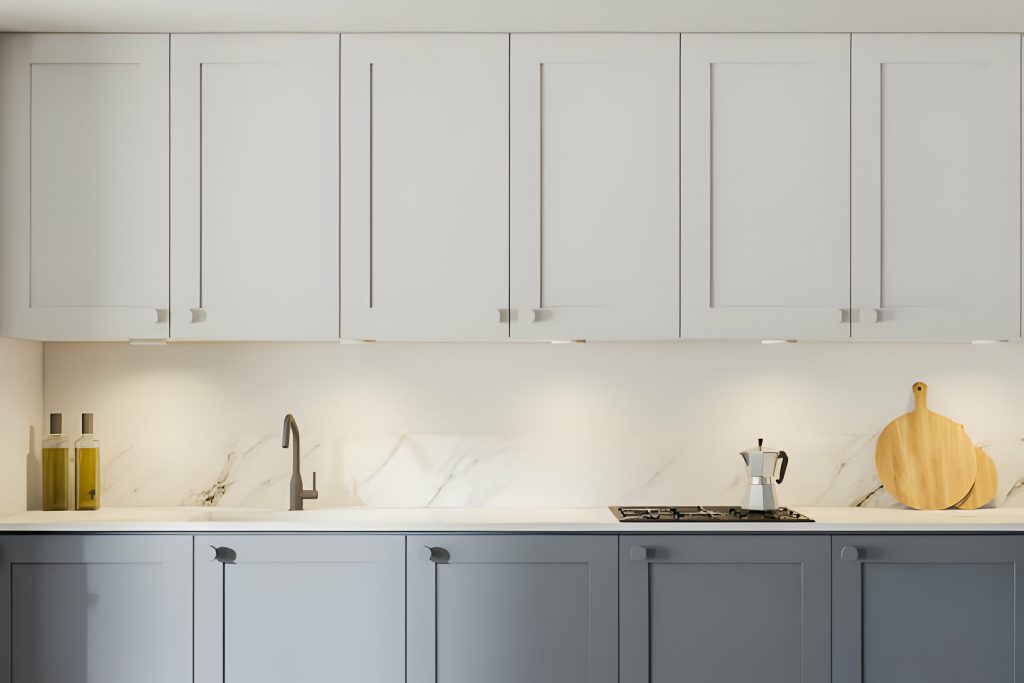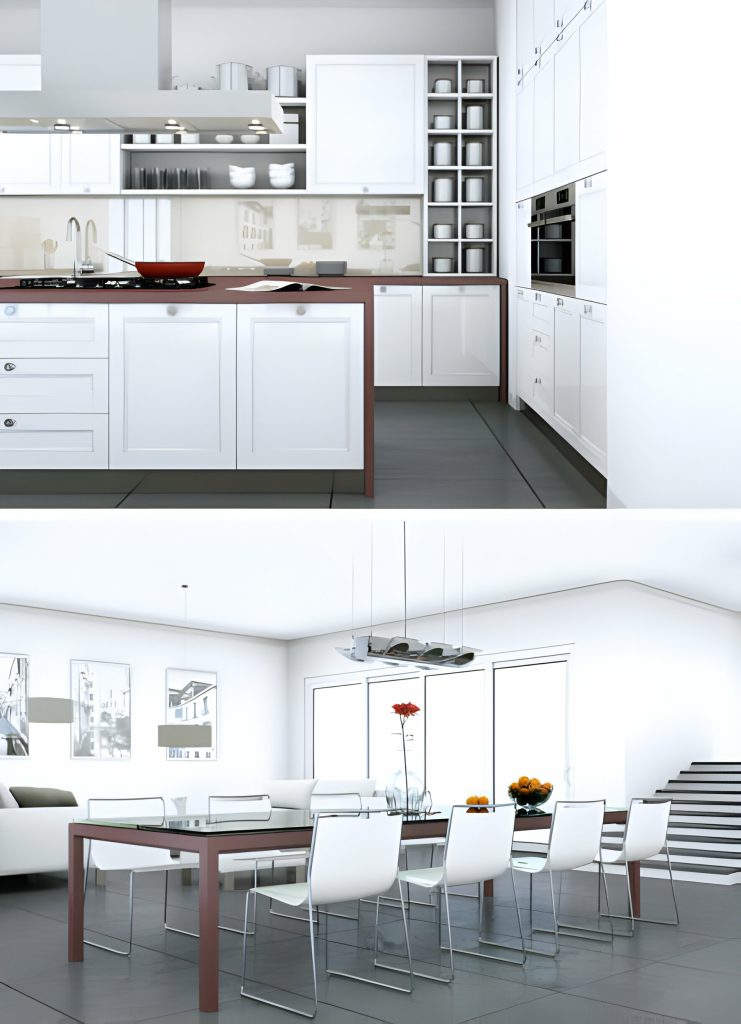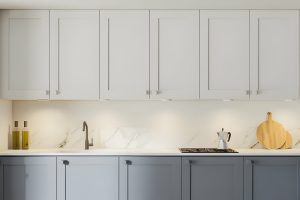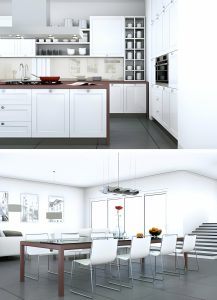If you’re looking to add a touch of elegance and sophistication, it’s time to consider putting glass in your kitchen cabinet doors. This simple yet transformational DIY project will instantly elevate the look of your kitchen. In this article, we will guide you through the step-by-step process of measuring, choosing, and installing the perfect glass for your cabinet doors. Get ready to give your kitchen a stunning upgrade!
Tools and Materials
To begin installing glass in your kitchen cabinet doors, gather the necessary tools and materials. Before you start, make sure you have a tape measure, a pencil, a screwdriver, a putty knife, a glass cutter, safety glasses, silicone adhesive, and glass panels that are the right size for your cabinet doors.
Measuring techniques are crucial for a successful glass installation. Start by measuring the width and height of each cabinet door opening. Take precise measurements, accounting for any trim or molding around the edges. It’s important to measure twice to ensure accuracy.
When it comes to glass installation tips, remember to handle the glass panels with care to avoid any accidents or breakage. Wear safety glasses to protect your eyes during the installation process. Use a putty knife to remove any existing putty or adhesive from the cabinet door frame. Apply a thin layer of silicone adhesive to the frame, and carefully place the glass panel on top. Press it firmly to ensure a secure bond. Finally, use a screwdriver to attach any clips or brackets to hold the glass in place.
Removing Cabinet Doors
To successfully remove cabinet doors, you will need a few tools, including a screwdriver or drill with the appropriate bits, a pry bar or putty knife, and a tape measure. When handling the doors, be sure to support them properly to avoid any damage. It is important to also take safety precautions, such as wearing gloves and eye protection, to prevent any accidents during the removal process.
Tools Needed for Removal
You will need a screwdriver to remove the cabinet doors. This is an essential tool for the removal process. Start by locating the screws that hold the hinges in place. Use the screwdriver to unscrew these screws, taking care to keep them in a safe place. Once the screws are removed, gently lift the door off the hinges. If your cabinet doors have multiple hinges, repeat this process for each one. It is important to be cautious and handle the doors with care to avoid any damage. Remember, the removal process is a crucial step before you can proceed with glass cutting and replacing the cabinet doors with glass panels.
Proper Door Handling
To safely remove the cabinet doors, begin by locating the screws that hold the hinges in place. These screws are typically found on the interior side of the door. Use a screwdriver to carefully loosen and remove the screws. It is important to support the weight of the door as you remove the last screw to prevent it from falling and causing damage. Once the screws are removed, gently lift the door off the hinges. It is advisable to have a helper assist you in this process, especially if the door is heavy. Proper door handling is crucial for door maintenance and the longevity of the door hardware. Take your time and be cautious to avoid any accidents or damage during the removal process.
Safety Precautions Emphasized
When removing cabinet doors, prioritize safety by carefully handling and supporting the weight of the door throughout the process. This ensures that you avoid any accidents or injuries. In addition to proper door handling, there are other safety measures you should take into consideration. Firstly, wear protective gloves to prevent cuts or injuries while handling the door. Secondly, use caution when removing any screws or nails that may be securing the door in place. Lastly, be mindful of any sharp edges or corners on the door that could cause harm. By following these safety precautions, you can ensure a smooth and incident-free process of removing cabinet doors.
| Safety Measures | Glass Cutting Techniques |
|---|---|
| Wear protective gloves | Measure and mark the glass accurately |
| Use caution when removing screws/nails | Score the glass along the marked line |
| Mindful of sharp edges/corners | Apply pressure to break the glass along the scored line |
| Support door weight throughout the process | Smooth the edges of the glass with sandpaper |
Measuring and Choosing Glass
To ensure a proper fit and selection, start by measuring the dimensions and considering the type of glass for your kitchen cabinet doors. Here are some important steps to follow when measuring and choosing glass:
- Measure accurately: Use a tape measure to determine the height and width of the cabinet door opening. Take precise measurements to ensure the glass fits perfectly.
- Consider the glass types: There are various types of glass to choose from, each with its own characteristics. Some popular options include clear glass, frosted glass, seeded glass, and decorative glass. Consider the style and functionality you want to achieve when selecting the glass type.
- Assess the cabinet style: Take into account the overall style of your kitchen cabinets. Choose a glass type that complements the cabinet design and enhances its aesthetic appeal.
- Consult a professional: If you’re unsure about the measurements or which glass type to choose, it’s always a good idea to seek advice from a professional. They can provide guidance and recommend the best glass installation techniques for your specific needs.
Preparing the Cabinet Doors
Now, you can begin the process of preparing your cabinet doors for the installation of glass. Before you start, make sure to gather all the necessary tools: a screwdriver, sandpaper, a tape measure, and a pencil.
First, remove the cabinet doors from their hinges using the screwdriver. Lay them flat on a clean, sturdy surface. Next, inspect the doors for any rough or uneven spots. Use sandpaper to smooth out these areas, ensuring a flat surface for the glass to be installed.
Measure the dimensions of each cabinet door carefully. This will help you determine the size of the glass needed. Take note of these measurements and keep them handy for the next step.
Now, it’s time to choose the type of glass you want to use. There are various options available, such as tempered glass, frosted glass, or even decorative glass. Consider the style and functionality you desire for your kitchen cabinets.
If you prefer not to go through the glass cutting process yourself, you can always opt for alternative materials. Acrylic or polycarbonate sheets can be used as a substitute for glass. They are lightweight, durable, and easy to work with.
Once you have prepared the cabinet doors and chosen the type of glass or alternative material, you are now ready for the next step: installing the glass into your kitchen cabinet doors.
Installing the Glass
Now that you have prepared the cabinet doors, it’s time to move on to installing the glass. The first thing to consider is the thickness of the glass. You have several options, ranging from 1/8 inch to 1/4 inch, depending on your preference and the style of your kitchen. Once you have chosen the right thickness, it’s important to secure the glass properly to ensure it stays in place and doesn’t pose a safety hazard.
Glass Thickness Options
When installing the glass in your kitchen cabinet doors, consider the various thickness options available. The thickness of the glass you choose will affect both the visual appeal and the durability of your cabinet doors. Here are four common glass thickness options to consider:
- 1/8 inch (3mm): This is the thinnest glass option and is commonly used for lightweight cabinet doors. It is easy to cut and provides a sleek and modern look. However, it is more prone to breakage and may not be suitable for heavy usage.
- 3/16 inch (5mm): This glass thickness offers a bit more durability than the 1/8 inch option. It is still relatively thin and provides a modern appearance. It is a good choice for cabinets that will be used frequently.
- 1/4 inch (6mm): This is a popular choice for cabinet doors as it provides a balance between durability and aesthetics. It is sturdy enough to withstand daily use and offers a substantial feel.
- 3/8 inch (10mm): If you want a more substantial and luxurious look for your kitchen cabinet doors, 3/8 inch glass is a great option. It provides excellent durability and a high-end appearance.
Consider the weight of the glass, the style of your kitchen, and your personal preferences when selecting the thickness for your cabinet doors.
Securing Glass Properly
To properly secure the glass in your kitchen cabinet doors, begin by attaching it using a strong adhesive. Before applying the adhesive, ensure that the glass is clean and free of any dirt or grease by thoroughly cleaning it with a glass cleaner. This will help the adhesive bond properly to the glass surface. Once the glass is clean, carefully apply a thin layer of adhesive to the back of the glass panel, ensuring even coverage. Next, gently press the glass panel onto the cabinet door frame, making sure it is aligned properly. Allow the adhesive to dry according to the manufacturer’s instructions. After the adhesive has dried, it is recommended to seal the edges of the glass with a glass sealing product to prevent any moisture or dirt from getting inside the cabinet. This will help maintain the longevity of the glass and ensure a secure fit within the cabinet door.
Reattaching the Cabinet Doors
Attach the cabinet doors back onto the kitchen cabinets using a screwdriver and the original hinges. Here’s how to properly reattach the cabinet doors:
- Remove the Hinge Pins: Start by removing the hinge pins from the hinges on the cabinet frame. This will allow you to easily attach the doors back onto the cabinets.
- Align the Hinges: Place the doors in front of the cabinet openings and align the hinges with the holes on the cabinet frame. Make sure the hinges are properly aligned to ensure a smooth and secure attachment.
- Insert the Hinge Pins: With the hinges aligned, insert the hinge pins back into the hinges on the cabinet frame. Use a screwdriver to gently tap the pins in until they are fully inserted and secure.
- Adjust Door Alignment: Once the doors are attached, check if they are properly aligned. If the doors are not level or aligned correctly, use a screwdriver to adjust the hinges. Loosen the screws on the hinges and carefully move the doors until they are in the desired position. Tighten the screws to secure the hinges in place.





